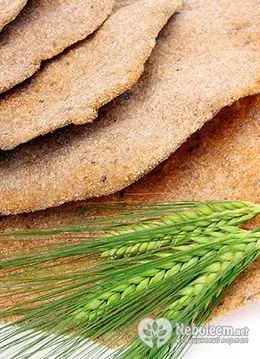- Author Rachel Wainwright [email protected].
- Public 2023-12-15 07:39.
- Last modified 2025-11-02 20:14.
Bread

Bread is obtained by baking, by frying dough or by steam processing. At the base of this product, two ingredients must be present - flour and water, the rest is optional and depending on the recipe. More often than not, salt, yeast, or baking powder are also added to bread. The flour used to make the dough is usually made from wheat, rye, corn, and barley.
Bread can be used both separately and as part of a sandwich, applying oils, jam, honey, etc. to it.
The history of this product goes back several thousand years. In the early Neolithic, it looked like a baked gruel made from cereals and water. In some cultures, this method of making bread is still relevant today.
Bread based on yeast dough was first prepared in Egypt, where it was possible to bring out a special type of wheat that does not require preliminary drying and roasting and contains gluten in the required amount.
The variety of types of bread amazed even in ancient times. Thus, Athenaeus, an author from Ancient Greece, described in his works cakes, loaves, bread curls and other varieties of the product.
In the Middle Ages in Europe, bread was not only part of the diet, but also an element of table setting. For example, the standard serving meant serving a small piece of stale bread that served as a plate. It was customary to eat them after eating.
In all countries, white breads were the prerogative of the wealthy, while the poor were content with rye bread. Only in the 20th century did preferences completely change, as priorities also changed: wealthy people watched over their health and chose black, healthier bread, the poor only needed to get nutrients and satisfy their hunger, which is why their choice fell to white.
Today, the variety of varieties of this flour product is impressive. In each country, one or another variety is considered traditional:
- for Russia, Ukraine and Belarus - a loaf;
- for the USA - bagel;
- for Germany - pretzel;
- for France - brioche or baguette;
- in Italy - ciabatta;
- in Israel - matzah, etc.
Composition, nutritional value and calorie content of bread
Bread, especially fresh, contains a huge list of vitamins. First of all, these are vitamins of group B, of which it is found in abundance: B9, B6, B2, B5, B1. In addition, the composition of the bread is enriched with the content of choline, beta-carotene and vitamins PP, E, H, A. Along with this, the list of contained minerals in bread is surprisingly extensive: cobalt, chromium, molybdenum, manganese, iodine, copper, iron, zinc, sulfur, chlorine, potassium, phosphorus, magnesium, sodium, calcium - almost all the useful part of the periodic table.
The calorie content of bread varies and directly depends on the composition. Thus, the calorie content of rye bread is 181 Kcal per 100 g. The ratio of proteins, carbohydrates and fats is 6.6 g, 34.2 g and 1.2 g, respectively. The highest calorie content in light wheat bread is about 381 Kcal per 100 g. Nutritional value of this type: 9.2 g of proteins, 5.2 g of fat, 78.3 g of carbohydrates.
Useful properties of bread
It cannot be said that the benefits of bread do not differ from grade to grade. The components included in the product determine not only its calorie content, but also the beneficial qualities that bread carries in itself. The content of nutrients in white bread is minimized. It is believed that the processing of grain, which is necessary for the manufacture of premium flour, is lost most of the nutrients that are contained in the grain shell. Such bread, as a rule, is soft, fluffy, but its composition is replete with starch and extra calories. The benefits of this type of bread are minimal, because the percentage of nutrients in it is hardly more than 30% of the original.
However, this does not mean at all that bread on the table should be abandoned. The main thing is to choose the right type of this bakery product. One of the most useful types of bread is considered to be "gray", with the addition of rye flour. It is absorbed more slowly and contains more minerals and vitamins than its white counterpart, it is he who, to a greater extent, has the beneficial properties of bread.
An ideal option for lovers of bakery products is bran bread. The benefits of bran bread are due to their ability to absorb allergens and toxins, strengthen the immune system, and provide the body with much-needed fiber, protein and vitamins. It has been proven that regular consumption of bread containing bran helps to reduce the incidence of diseases of the gastrointestinal tract and atherosclerosis. In addition, those who prefer bran bread to white bread are less likely to experience the difficulties associated with being overweight. Nutritionists recommend using this type of bread for patients with hypertension, as well as for constipation, gallstone disease, obesity.

The growing popularity of yeast-free bread based on hop sourdough has a number of useful qualities: it has a mild hypnotic, as well as choleretic, anti-inflammatory and expectorant effects. The use of such a product increases appetite and helps to normalize the menstrual cycle in women.
Harmful properties of bread
As noted above, the harm of bread lies in the excessive consumption of those varieties that contain extra calories, while not being enriched with useful substances. Many nutritionists and doctors are of the opinion that the development of many diseases is triggered by the use of high-grade flour products in quantities several times higher than the norm.
Studies show that excessive consumption of such foods causes exacerbation of cardiovascular, endocrine, gastrointestinal and oncological diseases. In addition, the frequent inclusion of white bread in the diet increases the likelihood of diabetes mellitus several times. At the same time, it is noted that the hereditary factor in this case does not play a role - the reason for the development and progression of the disease lies solely in the quality and quantity of food consumed.
Finally, the harm of daily use of bread is that the increased acidity inherent in wheat has a detrimental effect on tooth enamel.
In other words, the harm of bread, as is often the case, is not in the product itself, but in the absence of measure during its consumption.
Found a mistake in the text? Select it and press Ctrl + Enter.






